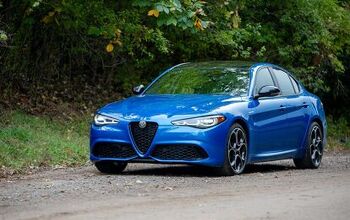Put on a Happy Face: 2020 Toyota Highlander Dons New Platform, Ditches Old Engine

There’s no other way to say it. Toyota’s Highlander is a bonafide success story, and the next-generation model appearing for 2020 will undoubtedly continue the midsize crossover’s built-in popularity, regardless of what Corey thinks of the new grille.
Toyota debuted the new Highlander on Wednesday, calling attention to a new platform shared with the Toyota Avalon and Lexus ES and a hybrid variant that blows the previous model’s fuel economy out of the water.
Yes, for 2020 buyers can kiss the old 2.7-liter base four-cylinder goodbye, not that many buyers ever opted for that underpowered mill. All gas-only Highlanders now source their power from a 3.5-liter V6 rated at 295 hp and 263 lb-ft of torque. No change in output there, nor in the engine’s dance partner — an eight-speed automatic.
A stop-start system now comes standard, so expect a mild uptick in fuel economy.
The big powertrain news is that the popular hybrid variant ditches its V6 companion in favor of a 2.5-liter four-cylinder. Tethered to twin electric motors and a revised transaxle, the engine and its electric assistants deliver a combined output of 243 hp. While that’s significantly less than the previous version’s 306 hp, the reduction in weight and friction losses means drivers will spend less money to keep theirs on the road. Toyota estimates a combined fuel economy figure of 36 mpg — a full 7 mpg improvement over the previous thriftiest Highlander.
Besides that, buyers will now be able to choose their Highlander Hybrid in either front-drive or all-wheel drive, a departure from the previous-gen’s AWD-only proposition. In this case, calling upon the AWD system spins an electric motor that drives the rear wheels independently from the gas engine.
Beyond the new styling, which is fairly evolutionary in nature (at least when viewed from a side-on angle), Toyota has designed the newest Highlander to be more user-friendly. Stretching an extra 2.4 inches from stem to stern, the model adds additional volume to the all-important rear cargo area. Three-row crossovers aren’t known for their acreage aft of the rearmost seats, but the 2020 Highlander does manage to eke out some extra room — total volume back there grows from a measly 13.8 cubic feet to 16 cubic feet. With third row folded down, cargo volume expands from 42.3 cubic feet to 48.4 cubes.
Helping the knees of third-row passengers is a second-row seat that slides an extra 1.2 inches. In base L and volume LE trim, the middle row is a three-person bench. XLE and Limited customers will find standard captain’s chairs, though they can option their Highlander with eight-passenger seating if required. Only the top-flight Platinum takes the bench off, erm, the table.
Platinum buyers, of course, will be too busy gazing at their 12.3-inch multimedia screen and standard 20-inch wheels (plebs get an 8-inch screen, though Limited buyers also gain access to 20-inch hoops).
Riding atop Toyota’s long TNGA-K platform, the Highlander is no doubt a stiffer, quieter, and more refined vehicle than before; whether buyers notice or even care is another story. Highlander sales rose to a new high in 2018 (244,511), and sales through November of this year show only a 1.1-percent decrease in popularity. The Highlander is built to sell, and sell it does.
With extra space and MPGs in tow, as well as standard Toyota Safety Sense 2.0 (which includes full-speed dynamic cruise control and pre-collision braking), the 2020 Highlander is positioned to succeed. Our jaws would be on the floor if it didn’t.
Going on sale in February 2020, the next-gen Highlander starts at $35,720 after destination. The cheapest AWD model starts at $37,320, while the entry-level hybrid — not available in base L trim — stickers for $39,320. Add another $1,600 if you want your hybrid with AWD.
[Images: Toyota]

More by Steph Willems
Latest Car Reviews
Read moreLatest Product Reviews
Read moreRecent Comments
- ToolGuy TG likes price reductions.
- ToolGuy I could go for a Mustang with a Subaru powertrain. (Maybe some additional ground clearance.)
- ToolGuy Does Tim Healey care about TTAC? 😉
- ToolGuy I am slashing my food budget by 1%.
- ToolGuy TG grows skeptical about his government protecting him from bad decisions.





































Comments
Join the conversation
Looks like a giant startled insect from the netherworld, with specialized cheek pouches for storing worms with a little beady eye peering out of each. Loathsome. The same crews who created that CH-R were given specific parts of this car to design, but each team were told to never talk to the other teams. The corporate stitchers put the thing together in CorelDraw from 1992. Toyota is number one in sales worldwide. I suppose that reduces the need to style handsome cars and instead indulge in fantasy while popping Tums to ease the quease. Wouldn't want to become a monopoly or anything by producing cars that people looked at and said - Hey, now that looks nice!
36 mpg combined for a 7 seat mid-size SUV? Even if that's in lab conditions, getting anything approaching 30 combined in this class is pretty remarkable. This class is all around 200 inches and weigh...what 4500+ lbs and more?